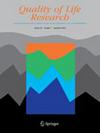Angela M Stover, Debbie Liang, Dana Mueller, Rachel Kurtzman, Christiana Ikemeh, Courtney Canter, Sonali Acharya, Jill Brese, Kaitlyn Buhlinger, Kevin Chen, Evan W Colmenares, Aimee Faso, Benyam Muluneh, Bianka Patel, Jeffrey S Reichard, Rushabh M Shah, Michael Tilkens, John Valgus, Lorinda A Coombs, Jennifer Elston Lafata, Jennifer L Lund, Emily M Ray, Gita Mody, Mary-Haston Vest
下载PDF
{"title":"药剂师协助的患者报告结果测量(PROM)监测:开发 EHR SmartForm©,用于在常规远程医疗会诊期间监测口服溶瘤药的副作用。","authors":"Angela M Stover, Debbie Liang, Dana Mueller, Rachel Kurtzman, Christiana Ikemeh, Courtney Canter, Sonali Acharya, Jill Brese, Kaitlyn Buhlinger, Kevin Chen, Evan W Colmenares, Aimee Faso, Benyam Muluneh, Bianka Patel, Jeffrey S Reichard, Rushabh M Shah, Michael Tilkens, John Valgus, Lorinda A Coombs, Jennifer Elston Lafata, Jennifer L Lund, Emily M Ray, Gita Mody, Mary-Haston Vest","doi":"10.1007/s11136-024-03789-8","DOIUrl":null,"url":null,"abstract":"<p><strong>Purpose: </strong>Patient reported outcome measures (PROMs) are increasingly used in oncology care, but pharmacists providing direct patient care have been overlooked. We engaged pharmacists and adults receiving oral oncolytics (chemotherapy medication taken by mouth) to develop a SmartForm© in the electronic health record (EHR) for PROM monitoring. Pharmacists verbally ask the patient side effect questions during routine telehealth encounters and enter responses in real time.</p><p><strong>Methods: </strong>Our development process was guided by the Knowledge to Action Framework. In phase 1 (Knowledge Inquiry), we prioritized side effects to assess in the EHR SmartForm© via interviews with patients and a Delphi panel with pharmacists. Adults receiving oral oncolytics for breast (n = 12), thoracic (n = 12), or hematological (n = 12) cancer were interviewed, with purposeful sampling for adults who were aged 65 + years or Black. Interviews were coded with content analysis. We conducted three Delphi rounds, with 11/19, 13/19, and 19/19 pharmacists, respectively. In phase 2 (Knowledge Synthesis), PROM items were selected and the EHR SmartForm© programmed. In phase 3 (Knowledge Tailoring), we conducted usability testing with pharmacists.</p><p><strong>Results: </strong>Pharmacists and patients were consistent in prioritizing side effects of oral oncolytics and 10 were retained. Patients advocated asking whether they can do their usual activities, while pharmacists added medication adherence. Usability testing yielded suggestions to simplify the SmartForm©.</p><p><strong>Conclusion: </strong>By presenting screenshots of our SmartForm©, our findings are useful to other healthcare systems looking for a PROM solution integrated in the EHR, with a reasonable pharmacist/clinician workload, and no requirement for patients to have internet access/comfort.</p>","PeriodicalId":20748,"journal":{"name":"Quality of Life Research","volume":" ","pages":"201-217"},"PeriodicalIF":3.3000,"publicationDate":"2025-01-01","publicationTypes":"Journal Article","fieldsOfStudy":null,"isOpenAccess":false,"openAccessPdf":"https://www.ncbi.nlm.nih.gov/pmc/articles/PMC11802710/pdf/","citationCount":"0","resultStr":"{\"title\":\"Pharmacist-facilitated Patient Reported Outcome Measure (PROM) monitoring: developing an EHR SmartForm© to monitor side effects of oral oncolytics during routine telehealth encounters.\",\"authors\":\"Angela M Stover, Debbie Liang, Dana Mueller, Rachel Kurtzman, Christiana Ikemeh, Courtney Canter, Sonali Acharya, Jill Brese, Kaitlyn Buhlinger, Kevin Chen, Evan W Colmenares, Aimee Faso, Benyam Muluneh, Bianka Patel, Jeffrey S Reichard, Rushabh M Shah, Michael Tilkens, John Valgus, Lorinda A Coombs, Jennifer Elston Lafata, Jennifer L Lund, Emily M Ray, Gita Mody, Mary-Haston Vest\",\"doi\":\"10.1007/s11136-024-03789-8\",\"DOIUrl\":null,\"url\":null,\"abstract\":\"<p><strong>Purpose: </strong>Patient reported outcome measures (PROMs) are increasingly used in oncology care, but pharmacists providing direct patient care have been overlooked. We engaged pharmacists and adults receiving oral oncolytics (chemotherapy medication taken by mouth) to develop a SmartForm© in the electronic health record (EHR) for PROM monitoring. Pharmacists verbally ask the patient side effect questions during routine telehealth encounters and enter responses in real time.</p><p><strong>Methods: </strong>Our development process was guided by the Knowledge to Action Framework. In phase 1 (Knowledge Inquiry), we prioritized side effects to assess in the EHR SmartForm© via interviews with patients and a Delphi panel with pharmacists. Adults receiving oral oncolytics for breast (n = 12), thoracic (n = 12), or hematological (n = 12) cancer were interviewed, with purposeful sampling for adults who were aged 65 + years or Black. Interviews were coded with content analysis. We conducted three Delphi rounds, with 11/19, 13/19, and 19/19 pharmacists, respectively. In phase 2 (Knowledge Synthesis), PROM items were selected and the EHR SmartForm© programmed. In phase 3 (Knowledge Tailoring), we conducted usability testing with pharmacists.</p><p><strong>Results: </strong>Pharmacists and patients were consistent in prioritizing side effects of oral oncolytics and 10 were retained. Patients advocated asking whether they can do their usual activities, while pharmacists added medication adherence. Usability testing yielded suggestions to simplify the SmartForm©.</p><p><strong>Conclusion: </strong>By presenting screenshots of our SmartForm©, our findings are useful to other healthcare systems looking for a PROM solution integrated in the EHR, with a reasonable pharmacist/clinician workload, and no requirement for patients to have internet access/comfort.</p>\",\"PeriodicalId\":20748,\"journal\":{\"name\":\"Quality of Life Research\",\"volume\":\" \",\"pages\":\"201-217\"},\"PeriodicalIF\":3.3000,\"publicationDate\":\"2025-01-01\",\"publicationTypes\":\"Journal Article\",\"fieldsOfStudy\":null,\"isOpenAccess\":false,\"openAccessPdf\":\"https://www.ncbi.nlm.nih.gov/pmc/articles/PMC11802710/pdf/\",\"citationCount\":\"0\",\"resultStr\":null,\"platform\":\"Semanticscholar\",\"paperid\":null,\"PeriodicalName\":\"Quality of Life Research\",\"FirstCategoryId\":\"3\",\"ListUrlMain\":\"https://doi.org/10.1007/s11136-024-03789-8\",\"RegionNum\":3,\"RegionCategory\":\"医学\",\"ArticlePicture\":[],\"TitleCN\":null,\"AbstractTextCN\":null,\"PMCID\":null,\"EPubDate\":\"2024/10/15 0:00:00\",\"PubModel\":\"Epub\",\"JCR\":\"Q1\",\"JCRName\":\"HEALTH CARE SCIENCES & SERVICES\",\"Score\":null,\"Total\":0}","platform":"Semanticscholar","paperid":null,"PeriodicalName":"Quality of Life Research","FirstCategoryId":"3","ListUrlMain":"https://doi.org/10.1007/s11136-024-03789-8","RegionNum":3,"RegionCategory":"医学","ArticlePicture":[],"TitleCN":null,"AbstractTextCN":null,"PMCID":null,"EPubDate":"2024/10/15 0:00:00","PubModel":"Epub","JCR":"Q1","JCRName":"HEALTH CARE SCIENCES & SERVICES","Score":null,"Total":0}
引用次数: 0
引用
批量引用

 求助内容:
求助内容: 应助结果提醒方式:
应助结果提醒方式:


